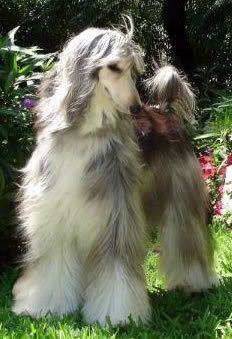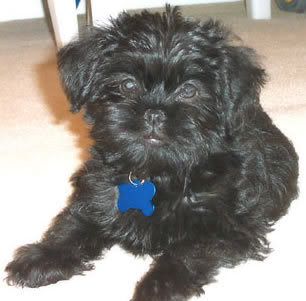 The Afghan Hound is a very old sighthound dog breed. Distinguished by its thick, fine, silky coat and its tail with a ring curl at the end, the breed acquired its unique features in the cold mountains of Afghanistan, where it was originally used to hunt wolves, foxes, and gazelles. Its local name is Ta-zi-. Other alternate names for this breed are Balkh Hound, Baluchi Hound, Barutzy Hound and Kabul Hound.
The Afghan Hound is a very old sighthound dog breed. Distinguished by its thick, fine, silky coat and its tail with a ring curl at the end, the breed acquired its unique features in the cold mountains of Afghanistan, where it was originally used to hunt wolves, foxes, and gazelles. Its local name is Ta-zi-. Other alternate names for this breed are Balkh Hound, Baluchi Hound, Barutzy Hound and Kabul Hound.Appearance of the Afghan Hound
The Afghan Hound is tall, standing 24 to 29 inches (63-74 cm) in height and weighing 45 to 60 pounds (20-30 kg). The coat may be any colour, but white markings, particularly on the head, are discouraged; many individuals have a black facial mask. Some are almost white, but particolour hounds (white with islands of red or black) are not acceptable and may indicate impure breeding. The long, fine-textured coat requires considerable care and grooming. The long topknot and the shorter-haired saddle on the back in the mature dog are distinctive features of the Afghan Hound coat. The high hipbones and unique small ring on the end of the tail are also characteristics of the breed.
Temperament of the Afghan Hound
The temperament of the typical Afghan Hound can be aloof and dignified, but happy and clownish when playing. The breed has a reputation among dog trainers of having a relatively low "obedience intelligence" as defined by author Stanley Coren. The Afghan Hound has many cat-like tendencies and is not slavish in its obedience as are some other breeds. The Afghan hound has a leaning towards independence. Owners should not be surprised if their Afghan hounds sometimes choose to ignore commands. Although seldom used today for hunting in Europe and America where they are popular, Afghan hounds are frequent participants in lure coursing events and are also popular as show dogs.
American Kennel Club temperament standard: "Aloof and dignified, yet gay. Faults--Sharpness or shyness."
Fédération Cynologique Internationale temperament standard: "The Afghan Hound should be dignified and aloof with a certain keen fierceness. The Eastern or Oriental expression is typical of the breed. The Afghan looks at and through one."
Mortality of the Afghan Hound
Afghan Hounds in UK surveys had a median lifespan of about 12 years,[2] which is similar to other breeds of their size.
In a 2004 UK Kennel Club survey, the most common causes of death were cancer (31%), old age (20%), cardiac (10.5%), and urologic (5%).
Morbidity of the Afghan Hound
Major health issues are allergies, and cancer. Sensitivity to anesthesia is an issue the Afghan hound shares with the rest of the sighthound group, as sighthounds have relatively low levels of body fat.
UKC brief historical summary of the Afghan Hound
History in Afganistan: "The use of the Afghan Hound for hunting in the mountainous terrain of Afghanistan required a dog that was highly intelligent and could survive by hunting on its own. The particular characteristics that distinguish the Afghan Hound from his desert-dwelling relatives enabled this breed to survive in the wide range of temperatures and the mountainous terrain of Afghanistan."
History in the West: "The first Afghan Hounds arrived in Great Britain with soldiers returning home from ... the eastern Empire during the early 1900's. After the first Afghan Hound created a sensation at the Crystal Palace show in 1907, the breed virtually disappeared in England [but] was revived ... after World War I. A number ... were exported to the United States in the 1920's. The [breed] was recognized by the United Kennel Club in 1948."
 The Affenpinscher is a terrier-like toy breed of dog.
The Affenpinscher is a terrier-like toy breed of dog.